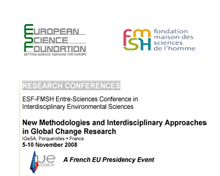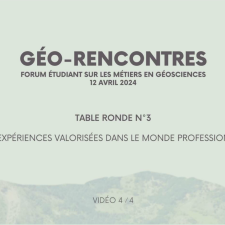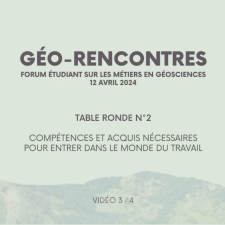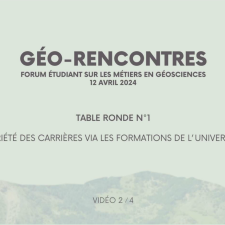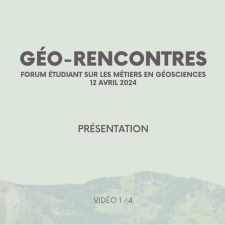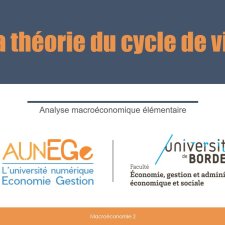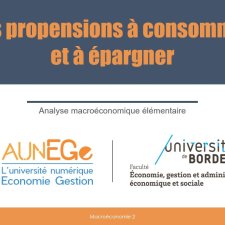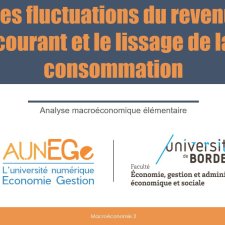Chapitres
- The Start and the End of Our Interglacial19'22"
- Discussion05'36"
Notice
The Start and the End of Our Interglacial
- document 1 document 2 document 3
- niveau 1 niveau 2 niveau 3
Descriptif
The previous interglacial (Marine isotope stage 5e, peaking at 125 kyr BP) is usually assumed to be a good analogue for our present-day climate. Moreover, as our present interglacial, the Holocene, is already almost 12 kyr long, paleoclimatologists were inclined to predict a quite close entrance into the next ice age. Simulations using the 2.5-D climate model of Louvain-la- Neuve show however that our interglacial will most probably last much longer than any previous one, even without human intervention (Berger and Loutre, 2002). It was suggested that this is related to the shape of the Earth’s orbit around the Sun which will be almost circular over the next tens of thousands of years. A circular orbit means indeed that the latitudinal and seasonal distributions of the energy received from the Sun will not vary anymore, a situation which will give more weight to the other forcings, in particular to the forcing by the greenhouse gases.
As the eccentricity variation is primarily related to the 400-kyr cycle, the best and closer analogue for such a forcing is definitively Marine isotopic Stage 11 (MIS-11) some 400 kyr ago and not MIS-5e. Simulations of this MIS-11 interglacial under greenhouse gas and astronomical forcings led indeed also to an anomalous length, a prediction which was later confirmed by the EPICA ice-core record.
Such a relationship between CO2 and climate is at the basis of the claim by Ruddiman (2003) that the impact of human activities on climate might have already started 10,000 years ago, preventing our climate to have already entered into glaciation. Sensitivity experiments with the LLN model tend to rule out Ruddiman’s hypothesis because glacial inception in this model would require CO2 concentration below 240 ppmv during the Holocene. However, honest estimates of model uncertainties incline us to leave the question open (Crucifix and Berger, 2006).
Our results show not only that the Holocene might last particularly long, but also that the sensitivity of our climate system to the greenhouse gas forcing might be exacerbated. It is therefore not surprising that, in our model at least, there is a threshold in the greenhouse gas concentration of about 700 ppmv beyond which the Greenland ice sheet melts in about 5000 years and does not recover before a few tens of thousands of years.
All these results confirm that the CO2 concentration in the atmosphere plays an important role in shaping the long-term climatic variations and that a detailed reconstruction of the interglacials from land, deep-sea and ice records is urgently needed.
Dans la même collection
-
Comparison of Simulated Tree-Ring Cellulose d180 at the European Scale
DANIS Pierre-Alain
In order to investigate factors involved in the inter-annual variability of d180 in tree ring cellulose (d18OTRC), we simulated the d18OTRC from 1960 to 2001 over Europe. We used 1) simulated climate
-
Borehole Climatology and Model Simulations: Steps to Integrated Assessment
GONZALES ROUCO Jesus Felipe
Progress in understanding climate variability through the last millennium leans on simulation and reconstruction efforts. Exercises blending both approaches present a great potential for answering
-
Food demand, Productivity Growth and the Spatial Distribution of Land and Water use: A Global Model…
POPP Alexander
Nowadays, human society appropriates about one quarter of total net primary production of the terrestrial biosphere. Production of food, energy and materials, and the related use of land and water
-
Turning Hazards into Ressources? Climate Change, Floods and Coastal Wetlands in the Costa Brava (No…
SERRA-LLOBET Anna
According to the IPCC Fourth Assessment, one of the most vulnerable areas in Europe are coastal zones. This is due to sea level rise combined with increased risks from storms. Coastal wetlands, in
-
Debate
HOURCADE Jean-Charles
SOMERVILLE Richard
SVEDIN Uno
DUVAL Romain
The European Science Foundation (ESF) and the French Foundation of the Maison des Sciences de l’Homme (FMSH) (within the Entre-Sciences programme) have agreed to jointly develop a new conference
-
Climatic Hazard Mitigation Through Risk and Resilience Committees in Nepal
RAJ ARYAL Komal
Nepal lies in an ecologically fragile and seismic region with a history of devastating Glacier Lake Outburst Flood (GLOF), landslides and earthquakes. Increases in temperature could increase the
-
Climate Models: learning from the Past Long-Term Climate Variability
JOUSSAUME Sylvie
Projections of future climate change rely on global climate models. Such models simulate the dynamics and physics of the coupled atmosphere-ocean system and move towards models of the full Earth
-
Data-Model Fusion Approach in Global Change Research: Recent Development and Future Challenges
PENG Changhui
It is increasingly recognized that global change research requires methods and strategies for combing process models and data in systematic ways. This is leading to research towards the application of
-
The Largest Lakes and reservoirs of Russia as a Priority Water Ressource for Society
LEMESHKO Natalia
Global change for the last 25 years drives to important changes in hydrometeorological regime in different regions, reflecting water resources change of the larges reservoirs and lakes of Russia and
-
Present-Day Geomorphological Changes in Polar Regions
ZWOLIńSKI Zbigniew
The landscape uniqueness of polar zone manifests itself in morphological traces of older glaciations and marine transgressions, areas of present-day glaciations, multi-year permafrost, multi-year snow
-
The Sustainability of Kyoto's Architecture: Where Did the Victims of Climate Change Go?
DUPUIS Johann
cept of “expropriation” in the case of territories exposed to a rise in sea levels. The premise of my project is that although future generations in all countries will be affected by climate change,
-
IPCC Working Group II
CHANZY André
The European Science Foundation (ESF) and the French Foundation of the Maison des Sciences de l’Homme (FMSH) (within the Entre-Sciences programme) have agreed to jointly develop a new conference
Avec les mêmes intervenants et intervenantes
-
Debate
BERGER A.
GUIOT Joël
MANN Michael E.
DANIS Pierre-Alain
AMATO Vincenzo
The European Science Foundation (ESF) and the French Foundation of the Maison des Sciences de l’Homme (FMSH) (within the Entre-Sciences programme) have agreed to jointly develop a new conference
Sur le même thème
-
Géo-Rencontres 2024 / Les expériences valorisées dans le monde professionnel
LILLO Emma
ARAUJO Julie
HUART Florian
DUBREU Romain
BUQUET Damien
CHAZAL Laura
BORIE Mariane
Forum sur les métiers en géosciences organisé par les étudiants du CMI Ingénierie Géologique et Civile, Université de Bordeaux, 12 avril 2024
-
Géo-Rencontres 2024 / Compétences et acquis nécessaires pour entrer dans le monde du travail
BRINON Juliette
AMOLE Fili-Fenua
PRETOU Frédéric
CAMPET Hugo
LIéBAUX Albin
DE ALEMEIDA Marie-Lou
POIRIER Aymeric
DUFRENOY Audrey
Forum sur les métiers en géosciences organisé par les étudiants du CMI Ingénierie Géologique et Civile, Université de Bordeaux, 12 avril 2024
-
Géo-Rencontres 2024 / Variété des carrières via les formations de l'université
INGUIMBERT Diane
LACAZE Romane
LEMAITRE Laurie
CHAZAL Laura
MONTJEAN Pascal
POUDEVIGNE Jacques
PORTEFAIX Frédéric
Forum sur les métiers en géosciences organisé par les étudiants du CMI Ingénierie Géologique et Civile, Université de Bordeaux, 12 avril 2024
-
Géo-Rencontres 2024 / Présentation
LATASTE Jean-François
LAVIE Théo
Forum sur les métiers en géosciences organisé par les étudiants du CMI Ingénierie Géologique et Civile, Université de Bordeaux, 12 avril 2024
-
Tokyo, plus grande « ville » au monde : aménager et gouverner la démesure
LANGUILLON-AUSSEL Raphaël
Avec ses quelques trente-cinq millions d’habitants, Tokyo est la « ville » la plus peuplée au monde, et l’une des métropoles les plus riches. Cette présentation vise à décrire, analyser et expliquer,
-
Demande en biens et services et fluctuations conjoncturelles
MAVEYRAUD-TRICOIRE Samuel
Demande en biens et services et fluctuations conjoncturelles
-
-
-
Les propensions à consommer et à épargner
MAVEYRAUD-TRICOIRE Samuel
Les propensions à consommer et à épargner
-
Le marché des biens et services à court terme
MAVEYRAUD-TRICOIRE Samuel
Le marché des biens et services à court terme
-
Les fluctuations conjoncturelles de l’activité
MAVEYRAUD-TRICOIRE Samuel
Les fluctuations conjoncturelles de l’activité
-
Les fluctuations du revenu courant et le lissage de la consommation
MAVEYRAUD-TRICOIRE Samuel
Les fluctuations du revenu courant et le lissage de la consommation


